Sarah Albee's Blog, page 16
November 24, 2014
Happy Thanksgiving!
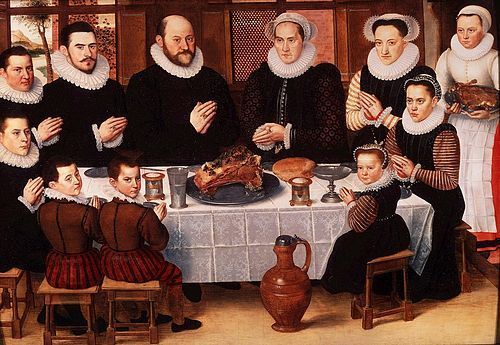
I am busy shopping, chopping, and cooking for lots of relatives this week, and will resume my blog next week. Have a wonderful holiday, all.
Antoon Claeissins, Family Saying Grace, 1585
The post Happy Thanksgiving! appeared first on Sarah Albee.
November 20, 2014
NCTE 14
 Today I’m leaving for the National Council of Teachers of English annual convention, held this year in Washington DC.
Today I’m leaving for the National Council of Teachers of English annual convention, held this year in Washington DC.
Tomorrow I’ll be on a panel from 2:30 PM to 3:45 PM with five other authors, moderated by Jeff Anderson.
 The subject of our discussion: KNOWING STORIES: HOW PUBLISHED AUTHORS AND STUDENT WRITERS IMPROVE THEIR CRAFT THROUGH THE USE OF MENTOR TEXTS
The subject of our discussion: KNOWING STORIES: HOW PUBLISHED AUTHORS AND STUDENT WRITERS IMPROVE THEIR CRAFT THROUGH THE USE OF MENTOR TEXTS
My fellow panelists will be: Erin Dionne, Varian Johnson, Kate Messner, Laurel Snyder, and Linda Urban.

Erin

Varian

Kate

Laurel

Linda
I’ll be autographing books at the Bloomsbury booth from 4 to 5, and then Friday night I’ll be at a dinner hosted by my publisher, Bloomsbury, along with fellow Bloomsbury authors Jennifer Brown, Megan Frazer Blakemore, and Annie Barrows.
I am really looking forward to meeting up with so many of my writer and teacher friends, and to actually meet friends that I’ve made on Twitter and Facebook!
The post NCTE 14 appeared first on Sarah Albee.
November 17, 2014
Thanksgiving, Back in the Day
I’m busy planning Thanksgiving dinner, and as I do every year, am frustrated by the tyranny of today’s menu, and my family and friends’ expectations. People are so hidebound nowadays, demanding turkey, stuffing, cranberry sauce, and pumpkin pie. It hasn’t always been the case. I found a treasure trove of old Thanksgiving menus from the nineteenth and early twentieth centuries at the UNLV Libraries digital collection, and I discovered that Thanksgiving menus in days of yore had so much more variety. Oysters, calves’ feet, turtle soup, and frogs’ legs factored into many of the menu offerings, as did a variety of boiled meats. And more meats. Not so much with the vegetables.
Come along with me on this trip through time!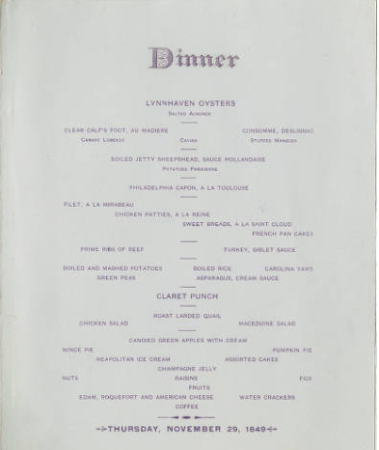 If we were at the Charleston Hotel in 1849, our Thanksgiving feast could start with clear calf’s foot, au madiere. We might move on to boiled jetty sheepshead, with a sauce Hollandaise, to be followed with sweetbreads (no, that’s not Cinnabon—it’s the thymus gland of a calf), roast larded quail, and candied green apples with cream.
If we were at the Charleston Hotel in 1849, our Thanksgiving feast could start with clear calf’s foot, au madiere. We might move on to boiled jetty sheepshead, with a sauce Hollandaise, to be followed with sweetbreads (no, that’s not Cinnabon—it’s the thymus gland of a calf), roast larded quail, and candied green apples with cream.
Getting hungry? Imagine the pages flying from the calendar, and now it’s November 29, 1883, and we’re at the Teegarden Hotel in La Porte, Indiana.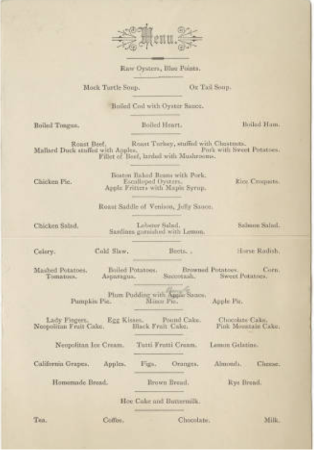 We could start with mock turtle or ox tail soup, then have the boiled cod with oyster sauce, followed by your choice of boiled tongue, boiled heart, or boiled ham. Then another choice: should it be roast beef, turkey, mallard duck, pork, or saddle of venison? But hey—they served vegetables eventually, around the fifth course (celery, cold slaw, beets, “horse radish,” potatoes, succotash).
We could start with mock turtle or ox tail soup, then have the boiled cod with oyster sauce, followed by your choice of boiled tongue, boiled heart, or boiled ham. Then another choice: should it be roast beef, turkey, mallard duck, pork, or saddle of venison? But hey—they served vegetables eventually, around the fifth course (celery, cold slaw, beets, “horse radish,” potatoes, succotash).
Some of the menu designs are quite beautiful, like this one from Revere House in 1884:
 Or hip late-fifties, like the Sands Hotel and Casino in Vegas, 1958:
Or hip late-fifties, like the Sands Hotel and Casino in Vegas, 1958:

 Some are flat-bizarre, like this one from the Grand Hotel in Cedar Rapids, Iowa. Note that the chef is reading a “proclamation” to the turkeys (a signed death warrant?), and holding a cleaver behind his back.
Some are flat-bizarre, like this one from the Grand Hotel in Cedar Rapids, Iowa. Note that the chef is reading a “proclamation” to the turkeys (a signed death warrant?), and holding a cleaver behind his back.
 Or this one, from the Revere House Hotel in Clinton, Iowa, 1884. Note how the turtle in the tureen holds the crab, which clamps down on the frog, its mouth agape, desperately trying to escape. They’re all on the menu.
Or this one, from the Revere House Hotel in Clinton, Iowa, 1884. Note how the turtle in the tureen holds the crab, which clamps down on the frog, its mouth agape, desperately trying to escape. They’re all on the menu.

The post Thanksgiving, Back in the Day appeared first on Sarah Albee.
November 13, 2014
A Dangerous Post: Read at Your Peril
Dear Reader, reading this blog post could be very dangerous. Please proceed with caution.
There’s a Monty Python skitcalled The Funniest Joke in the World where a British writer during WWII comes up with a joke so funny it causes people to die laughing. No one can read it and live. Eventually the lethal joke gets translated into (nonsensical) German as:
Wenn ist das Nunstück git und Slotermeyer?
Ja! Beiherhund das Oder die Flipperwaldt gersput!
We see two German soldiers keel over laughing, and the “joke warfare” continues to cut its deadly swath.
Here’s where we enter treacherous waters. Because I know of two instances in history of people who may actually have died laughing–and I’m going to tell you the jokes that killed them. So continue reading at your peril.

Chrysippus
Are you brave enough to keep reading? All right, here’s the first one, as recounted by the Ancient Greek chronicler, Diogenes Laërtius: In about 204 BC, the Greek philosopher Chrysippus watched a donkey eat some figs. He cried out: “Now give the donkey a drink of pure wine to wash down the figs!!!”
Ba-dum-BUM!
That was the joke.
He evidently thought his own joke was so hilarious, he promptly had a fit of laughing that killed him. Are you still alive? Good. Phew. I think what saved you is the fact that jokes are very hard to translate, despite the “success” of the translated killer joke in the Monty Python skit. Chrysippus’s hilariously lethal joke was translated from Greek, so it was probably way funnier in the original. Or perhaps, as they say, “you had to be there.”

Martin the Humane
Still with me? Ready for the second one?
In 1410, Martin the Humane, king of Aragon and Sicily, asked his jester, Borra, where he’d been. Borra replied that he’d been in the next vineyard, where he’d seen a deer hanging from a tree by its tail. Borra surmised that someone had punished the deer for stealing figs.
*cricket chirp*
That was the second joke. Martin was supposed to have died laughing after hearing that someone had hung a deer by its tail. It didn’t help that he was suffering from indigestion after eating an entire goose.
Well, now that you know two real-life, actual killer jokes, I hope you will use this powerful knowledge judiciously and responsibly. At the very least, don’t tell Martin the Humane’s joke at Thanksgiving dinner, especially if they’ve served goose. You could have serious carnage on your conscience.
http://en.wikisource.org/wiki/Lives_o... (see 185)
John Doran, The History of Court Fools (Boston: Francis A. Niccolls & Co., 1858), 377-378.
http://www.medievalists.net/2014/05/1...
The post A Dangerous Post: Read at Your Peril appeared first on Sarah Albee.
November 10, 2014
The Clash and The Titans
The Fatal Clash
On a hot June day in 1559, King Henry II of France galloped toward his jousting opponent at full speed. His opponent was the young captain of his Scottish Guard, Gabriel Count de Montgomery. Montgomery had begged to be allowed to decline the joust, but King Henry had insisted.
The two horsemen met. There was a loud crack and Montgomery’s lance splintered. When they lowered the king to the ground and removed his helmet, they found a piece of wood had pierced his eye and another was protruding from his temple.
The two most celebrated physicians of the day were summoned: Andre Vesalius and Ambroise Parė. As the doomed king lay next to them, feverish and in agonizing pain, the two physicians put in a grisly room-service order: the severed heads of four recently executed criminals. They used these heads to try to re-create the king’s wounds.
Ten days later, he died, most likely of sepsis.
This story is not about what happened next—but what happened next, if you’re curious, is that Henry’s wife, Catherine de Medici, punted his long-time mistress, Diane de Poitiers, out the back door and went on to co-reign with a succession of three of their ten children—the frail Francis II, who died in 1560, the frailer Charles IX, who died in 1574, and the foppish and ineffectual Henry III, who would be murdered by a religious zealot in 1589.
No, this story is more about the two rock-star doctors, Ambroise Parė and Andreas Vesalius.

Ambroise Paré
Parė rose to fame as a result of his military surgical career. He’d discovered that battlefield patients who had received mild wound dressings made of eggs and oil of roses healed better than those who’d had corrosive acid or boiling oil poured onto their amputated stumps. Go figure. But this thinking was hot stuff at the time. This was a time when other surgeons believed that victims of gunshot wounds should be induced to sweat, so soldiers were buried in manure up to the neck. Not sure if that was before or after the boiling-oil-to-the-stump.

Andreas Vesalius
Vesalius was an eminent anatomist, which was saying something, because there were so few anatomists at the time. This was a time when surgeons had had very little opportunity to study anatomy using human cadavers, because it was against the law. Executed criminals were about the only corpses available, and there weren’t enough of them around. Most of the existing anatomy books were based on animal anatomy, rather than human. As a younger man, Vesalius had stolen bodies chained to gallows, and crept into cemeteries under cover of darkness, hiding bones under his coat for the purpose of studying them. Many medical schools were obliged to form dodgy alliances with grave robbers and murderers to be assured a supply of bodies for dissection. (You can read my blog post about that here.) But his tenacity paid off: Vesalius published a seven-volume, groundbreaking work on human anatomy.
Still, despite their combined expertise and experience, both doctors clearly felt some pressure not to mess up. Hence the decapitated heads in Henry’s sickroom. But poor Henry was beyond help.
My favorite story of Vesalius’s dissection lecture-demonstrations is when a group of his medical students found a corpse, and, to avoid the prying eyes of law-enforcers, they dressed it up, and “walked” it into the dissecting room, as though it were a drunken student being dragged into class.
Sources: Lois N. Magner, A History of Medicine. New York: Marcel Dekker, Inc. 1992
Leonie Frieda, Catherine de Medici, Renaissance Queen of France. New York: HarperCollins, 2003.
The post The Clash and The Titans appeared first on Sarah Albee.
November 6, 2014
Mummy Dearest

JB in his early years
The subject of today’s blog is Jeremy Bentham (1748 – 1832). What? You’ve never heard of Jeremy Bentham? Why, he was an English moral and political philosopher, influenced by Locke and Hume, and the acknowledged “Father of Utilitarianism.” Among his followers were John Stuart Mill and other legal theorists and Consequentialists.
I see you suppressing that yawn.
Well JB had a devilish side. His dying request was that an auto-icon be made out of his dead body.
What? You don’t know what an auto-icon is? Why, it’s a cabinet that holds a mummified human body, as far as I can determine. Here’s a picture of his:

JB in his auto-icon
Photo by Michael Reeve, MykReeve at the English language Wikipedia
JB’s preserved skeleton has been fluffed out with stuffing and dressed in his own clothes. Also that’s not his real head; it’s a wax version. His disciple, Doctor Thomas Southwood Smith, who was assigned the task of preserving JB’s remains, tried a “new” way of mummifying the head, following a technique practiced by New Zealand Maoris. But the method went horribly wrong and the face, well, let’s leave it that they decided to make a new one out of wax. But evidently it’s his real hair. His cabinet was moved to University College in London in 1850, and it’s been a source of curiousity and student pranks ever since.
You can click here for a 360-degree, rotating picture of JB. It’s cool, although I get pretty carsick looking at him spin.
Sources: Internet Encyclopedia of Philosophy http://www.iep.utm.edu/bentham/
University College London: http://www.ucl.ac.uk/Bentham-Project/who/autoicon
The post Mummy Dearest appeared first on Sarah Albee.
November 3, 2014
Death by Voting?
Update: I thought I’d re-post this pre-election blog I wrote a couple of years ago, in honor of Election Day.
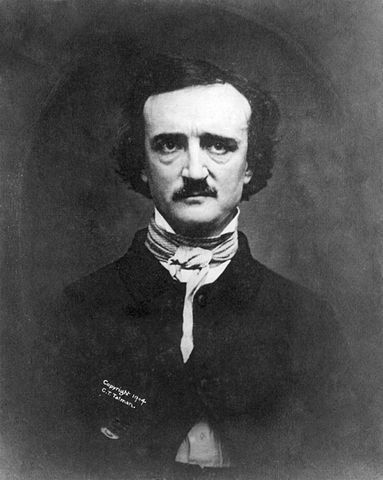 On the eve of the election I am sure you’re as weary as I am of voter intimidation stories, suspiciously long early voting waiting lines, and Super-PAC-funded negative advertising. But nineteenth century political campaigns make these things look tame by comparison. Today’s blog is about certain 19th century election practices, and how they might relate to the mysterious circumstances surrounding the death of the author Edgar Allan Poe.
On the eve of the election I am sure you’re as weary as I am of voter intimidation stories, suspiciously long early voting waiting lines, and Super-PAC-funded negative advertising. But nineteenth century political campaigns make these things look tame by comparison. Today’s blog is about certain 19th century election practices, and how they might relate to the mysterious circumstances surrounding the death of the author Edgar Allan Poe.
When I was a teenager I went through a major Poe phase, but it wasn’t until recently that I learned that the cause of his death, in 1849, was almost as mysterious and eerie as some of his stories. The three prevailing theories to explain the cause of his death are alcohol, rabies, and cooping. I’ll explain.
Here’s what we know: Poe struggled with alcohol for much of his adult life, and also with money problems. At the end of June, 1849, he began a lecture tour to raise money for a new magazine. He traveled to Philadelphia, Richmond, and Norfolk, Virginia. On September 27th, he took a boat from Richmond to Baltimore, but his subsequent whereabouts over the next few days are shrouded in mystery. He resurfaced on October 3rd, when a man named Joseph Walker discovered him outside a tavern and sent a note to Doctor J.E. Snodgrass, reporting that a gentleman had been found “rather the worse for wear,” in evident distress. Poe was delirious, and presumed to be in a drunken state, and sent on to Washington College Hospital.
Over the next four days, he lapsed in and out of consciousness and delirium, incoherent and unable to explain what had happened to him. He died four days later. He was forty years old.
So one explanation, the prevailing one for many decades, is that he was intoxicated and died of some sort of alcohol poisoning, But where that doesn’t really hold up is that he remained in the state of hallucinatory incoherence for four days, and refused offers of alcohol in the hospital (yeah, that’s about the best thing hospitals had to offer to sick people back then). One reason to explain the extended delirium is that he might have ingested a combination of alcohol and laudanum (he’d almost died of that combination a year before, whether from accidental overdose or a suicide attempt).
The second explanation comes from a paper published in 1996, by Dr. Michael Benitez, a cardiologist at University of Maryland Medical center. He suggested rabies may have killed Poe. Symptoms of rabies can take up to a year to appear, but once they do, the patient dies within a few days. Benitez cited as support for the rabies theory the fact that Poe refused water in the hospital. Hydrophobia (fear of water) is a symptom of rabies. But other sources claim Poe did drink half a glass of water, so without evidence of hydrophobia, the rabies theory is pretty slim. Others who subscribe to the disease explanation say that Poe might have been ill from cholera or tuberculosis or epilepsy.
And finally, there’s the cooping theory. I had to research this term. Cooping was a tactic used by crooked officials to sway voting, and was especially notorious in Baltimore during the 1840s and 50s (smack-dab during the time of Poe’s death). Political thugs not only bribed judges and stole ballots to get their candidates elected. They also resorted to kidnapping, beating, and murder. “Coopers” were known to have kidnapped innocent bystanders (always white males—the only ones who could vote), and hold them in a room (or “a coop,”) where they were often drugged, plied with liquor, or physically beaten, and then forced to go from polling place to polling place, voting over and over again for a particular candidate. Often their clothes were changed to disguise them from being recognized at the polls.
I found several accounts in newspapers from 1849 and 1850 bemoaning the practice of cooping. Here’s just one, from the State Gazette (Trenton, October 14 1850):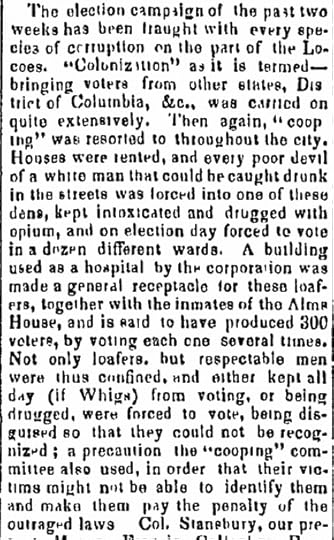 The day Poe was found happened to be election day, and the tavern outside of which Poe was found was also a voting place. And according to some accounts, when Poe was found he was wearing someone else’s clothing. Could he have been seized by a gang, plied with liquor, made to vote over and over again, and then turned out into the street?
The day Poe was found happened to be election day, and the tavern outside of which Poe was found was also a voting place. And according to some accounts, when Poe was found he was wearing someone else’s clothing. Could he have been seized by a gang, plied with liquor, made to vote over and over again, and then turned out into the street?
It’s a mystery.
Additional sources from the Poe Museum website: http://www.poemuseum.org/life.php
And from the Edgar Allan Poe Society of Baltimore website:http://www.eapoe.org
The post Death by Voting? appeared first on Sarah Albee.
October 30, 2014
Firm and Tone—the Medieval Way!
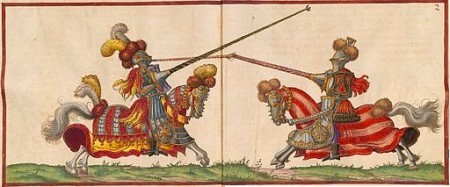 Want to train like a troubador? Crush it like a crusader? Become lean as Lancelot? Here’s how!
Want to train like a troubador? Crush it like a crusader? Become lean as Lancelot? Here’s how!
(Note: this workout is reserved for members of the nobility, males only of course. Before embarking on any physical exercise program, check with your governing feudal overlord to be sure this regimen is right for you.)
Your physical education begins at age fourteen, while you’re employed as a squire to a knight, and consists of vigorous sports such as hawking with a falcon, hurling stones, wielding a battle-axe, and casting a spear.
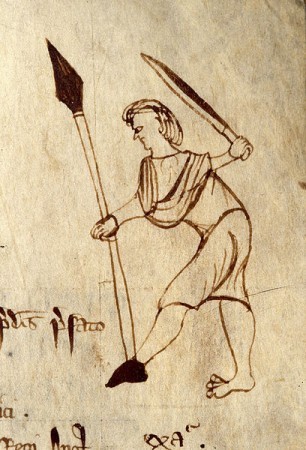 Most important of all, though, is getting on and off your horse. You’ll need to be able to leap into the saddle without using stirrups. Go ahead! Try it!
Most important of all, though, is getting on and off your horse. You’ll need to be able to leap into the saddle without using stirrups. Go ahead! Try it!
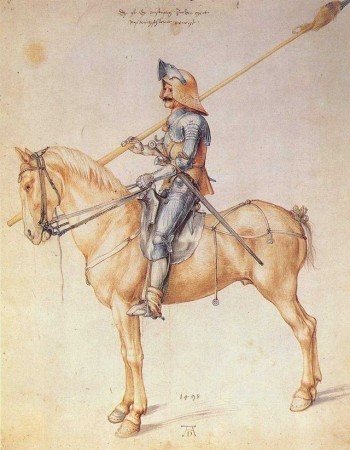 Still alive? Great! Now that you’ve mastered that, you’ll need to be able to leap down from the horse, while in mid-gallop, to pick up an “object” with agility. If this happens during a battle, the “object” may or may not be a part of your master’s anatomy.
Still alive? Great! Now that you’ve mastered that, you’ll need to be able to leap down from the horse, while in mid-gallop, to pick up an “object” with agility. If this happens during a battle, the “object” may or may not be a part of your master’s anatomy.
From this point on, most of your aerobic training will consist of games that prepare you for combat: hunting, wrestling, fencing, horse-racing, javelin throwing, and, the toughest workout of all, jousting. This consists of galloping full-speed toward your opponent (who will be galloping full speed toward you), while wielding a heavy lance aimed at his heart, and while wearing a cuirass, leg armor, and helmet with the visor down.
Caution: fatalities on the course occur frequently, due to suffocation, heat stroke, or getting pierced through by a long, metal, pointed object.

Source: Dr. Ludwig H. Joseph, Gymnastics from the Middle Ages to the 18th Century , 1949
The post Firm and Tone—the Medieval Way! appeared first on Sarah Albee.
October 27, 2014
Enlightened Thinker

Edward Jenner
Most people are familiar with the name Edward Jenner (1749 – 1823), a country doctor whose smallpox inoculation led to that dreaded disease’s eventual eradication. Jenner became intrigued by the fact that milkmaids who had contracted coxpox, similar to smallpox but much less serious, seemed immune to smallpox. He experimented with inoculating people with cowpox particles taken from the hand of a milkmaid, and found that they developed a mild case of the disease but were left immune to smallpox. In 1798 he published his findings, and by 1800 his vaccination had spread rapidly throughout Europe and the Americas, and it was considered by many to be the greatest medical achievement of the Enlightenment.
But health practitioners in Africa, China, India, and Turkey had been practicing a form of smallpox inoculation (called variolation) for centuries. The procedure involved taking fresh material from smallpox pustules and scratching it into the skin of a healthy person (or blowing it up the nostrils). It exposed patients to a significant risk of contracting the disease, but still had a major statistical advantage over doing nothing.
Enter Lady Mary Wortley Montagu (1689 – 1782), my new favorite Lady of the Enlightenment. She was the person who first introduced the smallpox inoculation procedure to England, decades before Jenner’s discovery. Married to the British Ambassador to the Turkish Court, she made friends with many Turkish people, learned their language, wore Turkish dress, and observed their customs—most notably, their practice of variolation. She had had smallpox herself, and her face was quite scarred. Her brother had died of it.

Lady Mary
She had her own six year old son Edward variolated in the Turkish manner by an old woman with a rusty needle, and then later, when back in England during a smallpox epidemic in 1721, she had her four year old daughter inoculated. The method impressed the (initially skeptical) physicians who witnessed it.
In response to the public outrage at this dangerous, sinful, “Oriental” practice, Lady Mary published “A Plain Account of the Inoculating of the Small Pox.” She even persuaded the Princess of Wales to inoculate her daughter (though not her sons—that was too risky).
Lady Mary also gained fame for a public spat with her former friend, Alexander Pope. It’s unclear what the quarrel was about—he might have declared his love for her and she may or may not have laughed in his face. Not easy to do, considering he was probably not taller than four foot six. Still, she was a woman unafraid to speak her mind, and way ahead of her time.
The post Enlightened Thinker appeared first on Sarah Albee.
October 23, 2014
Five Tips to A Healthy Pregnancy—the Renaissance Way
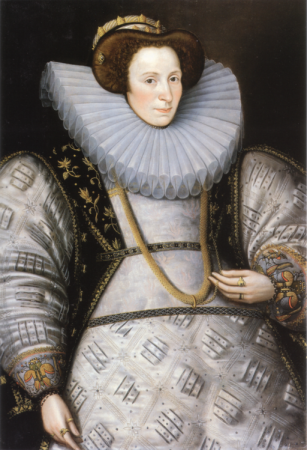 For some reason, I’ve been going to a lot of baby showers recently–I have another one Monday night. It’s fascinating to see all the new-fangled baby contraptions available these days, and to learn what has gone in and out and in again in the way of advice to pregnant women and new mothers. Doctors still advise pregnant women against pretty obvious things—don’t smoke, don’t drink alcohol, and try not to eat an entire pint of Ben and Jerry’s every night. I did a little research, and found that pregnant women have been given advice as long as there have been … pregnant women.
For some reason, I’ve been going to a lot of baby showers recently–I have another one Monday night. It’s fascinating to see all the new-fangled baby contraptions available these days, and to learn what has gone in and out and in again in the way of advice to pregnant women and new mothers. Doctors still advise pregnant women against pretty obvious things—don’t smoke, don’t drink alcohol, and try not to eat an entire pint of Ben and Jerry’s every night. I did a little research, and found that pregnant women have been given advice as long as there have been … pregnant women.
Here are five tips to producing a healthy—and most importantly, male—baby. They come from the health manual Ad mulieres ferrarienses, written by Michele Savonarola. He was a sixteenth century court physician to the Este family, rulers of Ferrrara. 1. “Most poultry is good for you, except for crane and peacock, which are hard to digest.”
1. “Most poultry is good for you, except for crane and peacock, which are hard to digest.”
2. “Eels are especially good for clearing the bronchial passages, and they also help with your singing voice.” [I guess it’s implied that eels are a good choice for a pregnant woman.]
3. Fruits are to be avoided: “When you crave a piece of fruit, just think that the most noble and beautiful fruit in the world is the human creature in your womb, so surely you can resist the vituperative claims of your palate for a vile, ugly, bad piece of fruit that will harm what you carry inside yourself.”
4. “In order to give birth to a healthy, warm, and dry-tempered male child, pregnant women should consume warm and dry foods.” [That means no Ben and Jerry’s.]
5. “Beware of using cold water, it is not good for the fetus and it causes the generation of girls, especially here in our region, so keep drinking wine.”

http://www.academia.edu/1359403/Fruit_of_the_Womb_Prenatal_Food_in_Renaissance_Italy
http://www.medievalists.net/2011/06/2...
The post Five Tips to A Healthy Pregnancy—the Renaissance Way appeared first on Sarah Albee.



